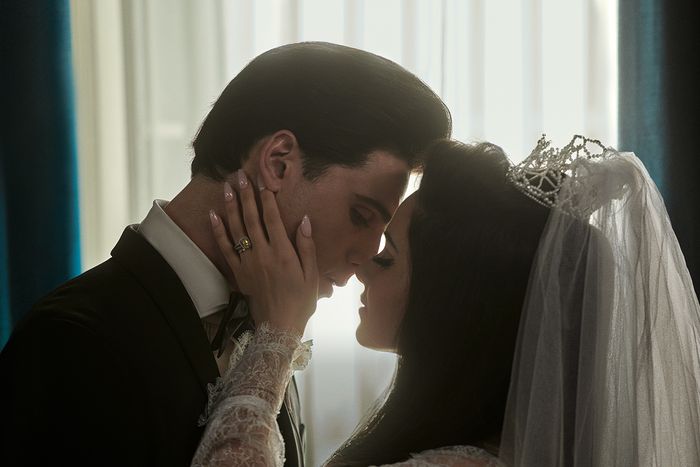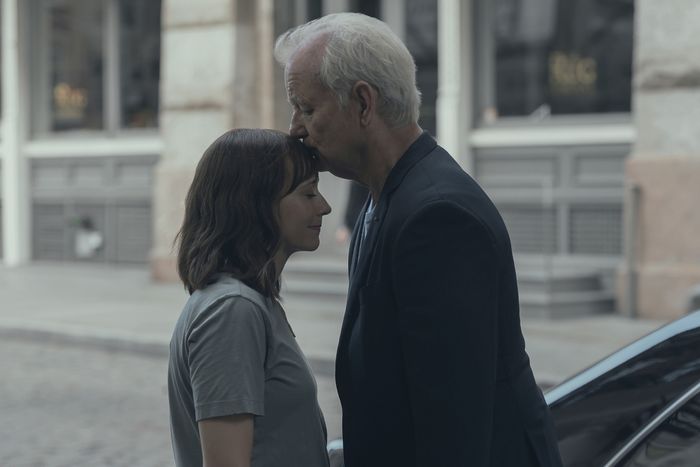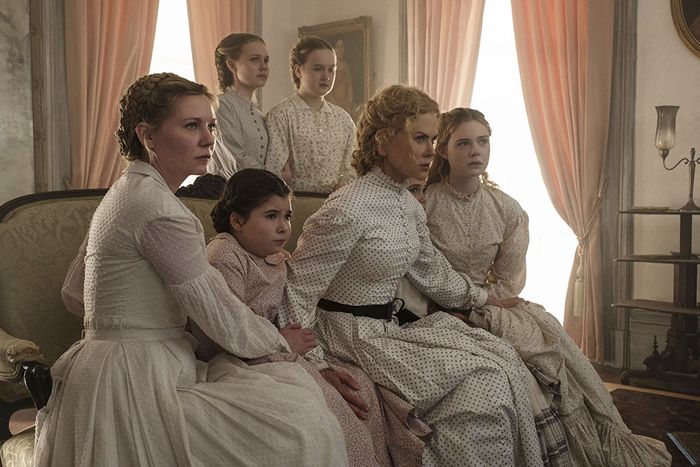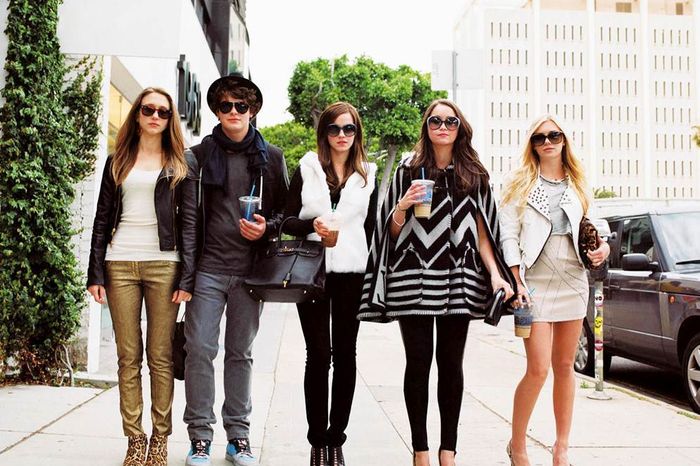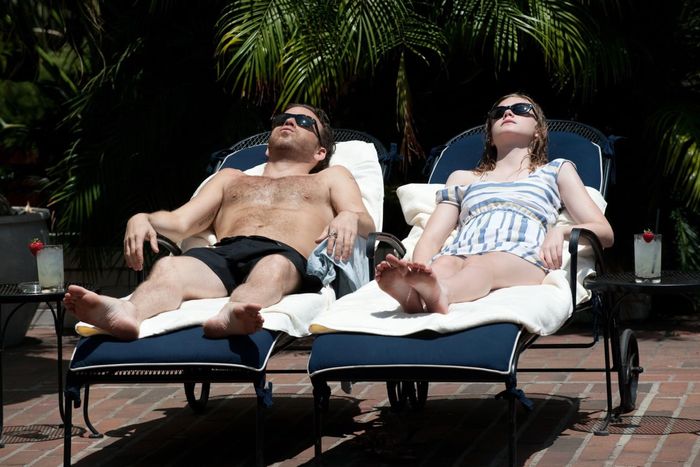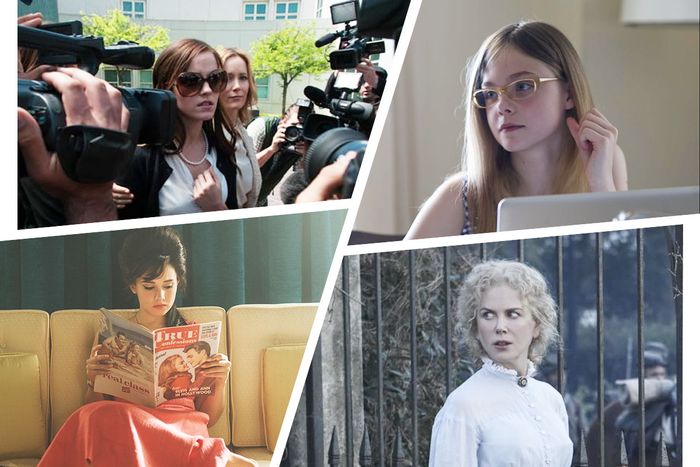
This article was originally published on November 8. We are recirculating it now timed to Priscilla’s digital release. Be sure to also read Alison Willmore’s review of the film and our interview with costume designer Stacey Battat.
Dolly Parton’s “I Will Always Love You” was blasting as Priscilla Presley drove through the gates of Graceland one last time — or, rather, as Cailee Spaeny drove through them. Sofia Coppola played the wistful ballad that would close Priscilla while Spaeny sat behind the wheel, her character steeling herself to leave Elvis and begin a life of her own. Tears stung Spaeny’s eyes as she heard Parton sing those famous words: “And so I’ll go, and yet I know / I’ll think of you each step of the way.”
Coppola is the author of her films in every conceivable way. But her husband, Thomas Mars, and his bandmates in Phoenix have long been indelible collaborators. Mars contributed vocals to the trippy Air tune “Playground Love,” heard at a turning point in Coppola’s 2000 debut, The Virgin Suicides. Phoenix’s “Too Young” plays during a party scene in Lost in Translation. And the entire quartet, most of whom started jamming together out of Mars’ childhood home in Versailles, cameo as 18th-century dandies serenading Kirsten Dunst’s eponymous queen in Marie Antoinette.
When Coppola starts to write a movie, she already has music in mind, and Mars and Phoenix will compile playlists that evoke the mood she wants to capture. Sometimes those songs make it into the film, like “I’ll Try Anything Once,” a demo by the Strokes that accompanies a tender father-daughter sequence in Somewhere. Coppola might also play them on set to put actors in a specific headspace, as she did with “I Will Always Love You” and Sleigh Bells’ “Crown on the Ground,” the rousing opening number in The Bling Ring.
But it was 2010’s Somewhere — released one year before Coppola and Mars married — when things advanced. That was the first Coppola movie Phoenix composed from start to finish, and they’ve scored each of her subsequent projects. Sometimes they join forces with veteran music supervisors, like longtime Coppola associate Brian Reitzell on The Bling Ring or Randall Poster on Priscilla. Other times, they fly solo, steadily building a score as Coppola’s dailies come through. Throughout the edit, they go frame by frame — or millisecond by millisecond, as Mars puts it — to make sure everything fosters the perfect mood.
Vulture spoke with Mars and Phoenix guitarist Laurent Brancowitz, virtuosos with an encyclopedic appreciation for music, about each of Coppola’s movies since Somewhere.
Priscilla (2023)
Mars and Brancowitz say the new Presley biopic required the most work they’ve done on a film. They listened to “thousands” of songs to find the right ones to depict Priscilla’s relationship with Elvis, which starts as an extended trance and then turns volatile. At first, Phoenix expected to use Elvis’ actual catalog, namely “Love Me Tender” and “Are You Lonesome Tonight?” They wanted the latter to demonstrate a teenage Priscilla’s boredom in West Germany, where her military family is stationed when she first meets Elvis. Because Elvis’ estate wouldn’t grant Coppola any song rights — “They don’t like projects that they haven’t originated, and they’re protective of their brand,” she told The Hollywood Reporter — Phoenix had to get creative. Fortunately, Brancowitz found the “Love Me Tender” melody in “Aura Lea,” a Civil War-era song available in the public domain. The band recorded a new version, skirting the estate’s strictures.
The rest of the film’s harmonies are equally indebted to Elvis’ taste. Eyeing a list of the vinyl records Elvis had at Graceland, they knew he liked gospel, Hawaiian music, and Christmas carols. So they melded those genres with a recurring motif from Frankie Avalon’s “Venus,” the song the real-life Priscilla says the Navy base diner was playing when one of Elvis’ friends invited her to meet the King (Jacob Elordi). Phoenix also covered the full Avalon hit, a celebration of desire that augurs Elvis’ interest in Priscilla. “It encapsulates the period well,” Brancowitz says. “Some songs are like that. They have the power to capture a moment in history.”
As is Coppola’s wont, anachronisms didn’t matter. After Priscilla’s first kiss with Elvis, we hear Tommy Jones and the Shondells’ slinky “Crimson and Clover,” even though it was recorded half a decade later. (Coppola blared that one on set, too.) For “Baby, I Love You,” the airy Ronettes bop from 1963, Coppola and Mars turned to a rock cover by the Ramones, who didn’t release their debut album until 1976, by which point Priscilla and Elvis had divorced. And for a makeover scene that unfolds after Elvis instructs Priscilla to wear a beehive and thicker eye makeup, they went all the way to 2007, using Dan Deacon’s electronic rapture “The Crystal Cat.”
On the Rocks (2020)
If Priscilla demanded the most time, On the Rocks demanded the most ingenuity. Taking inspiration from the way Miles Davis scored Elevator to the Gallows, Louis Malles’ 1958 thriller starring Jeanne Moreau, the band improvised much of the music. Projecting the film in a Paris recording studio, they conjured the sort of suave, ‘50s-style jazz that Bill Murray’s senior-citizen playboy liked.
“We’ve always wanted to try to do it this way,” Brancowitz says. “It’s a great way to do it because you are in the position of the spectator. You can live the emotion directly without having this fragmented vision you have when you work on a piece.”
Coppola listened to Chet Baker while writing the script, so Baker’s “I Fall in Love Too Easily” became On the Rocks’ opening number, introducing a hint of melancholy in the relationship between Rashida Jones’ stalled novelist and Marlon Wayans’ tech workaholic. From there, Phoenix brought their signature synth sound to compositions punctuated with horns and propulsive swing. When Murray and Jones cruise through Manhattan in a red vintage Alfa Romeo convertible, Brancowitz suggested using “In Orbit,” a trumpet-heavy instrumental by Thelonious Monk and Clark Terry.
In addition Elevator to the Gallows, Phoenix referenced everything from Michelangelo Antonioni to John Hughes. But Bob Fosse’s All That Jazz was the most influential precursor. Much like the famous Vivaldi concerto that recurs during Roy Scheider’s pill-popping morning rituals, a Michael Nyman recording that incorporates the Mozart opera Don Giovanni characterizes the sameness of Jones’ day-to-day life as a mother, writer, and increasingly suspicious wife.
The Beguiled (2017)
“What Beguiled score?” you might ask. For a movie that’s part thriller and part comedy of manners, Coppola’s underappreciated reimagining of Thomas P. Cullinan’s novel about a Civil War-era girls’ school features strikingly little music. Most of the ambiance comes from the noises of nature and the cannonfire softly blasting in the distance. Phoenix did test out a few recordings, but Coppola preferred only a low-pitched drone that briefly kicks in after the prim headmistress (Nicole Kidman) decides to amputate the leg of the wounded enemy soldier (Colin Farrell) she has agreed to house. “It had to be not melodic,” Brancowitz says. “It was more like sound design. We would have used elements from the period, like flutes. But it was really not what was needed.”
The only music that dominates a scene comes at the very end, as the women carry the soldier’s corpse across their front yard for the Confederate Army to collect. For that denouement, Phoenix used computer software to elongate a snippet of Monteverdi’s liturgically influenced Vespers for the Blessed Virgin, giving the moment a low-toned eariness. “You can stretch it without changing the tonality,” Brancowitz says. “Suddenly a bar of music can last one minute. It’s like you have a microscope and you go inside the DNA of these pieces.” The results play like a funeral dirge, the camera panning toward the women as they stand idly on their porch looking at the dead body swaddled in white bedsheets.
The Bling Ring (2013)
Coppola often says that each of her movies is a departure from the previous one, so maybe part of why The Beguiled had almost no music is because The Bling Ring had all the music. In addition to “Crown on the Ground,” Coppola’s saga about teenage thieves pumped M.I.A.’s “Bad Girls,” Kanye West’s “All of the Lights,” Reema Major’s “Gucci Bag,” and Frank Ocean’s Super Rich Kids.”
Each time the eponymous clique robs a celebrity’s house, the accompanying music has its own rhythm. “Sofia and [cinematographer] Harris Savides knew they wanted to shoot every robbery scene a different way,” Mars says. The first one, set to the Sleigh Bells wallop, was meant to be a total thrill, with the track’s saturated guitars galvanizing the kids’ spree. The next couple of robberies have no music, hinting at how prosaic this hobby would quickly become. And later, when the teens break into Lindsay Lohan’s house despite law enforcement openly targeting them, Phoenix composed a menacing hum that builds as their crime binge comes to a life-altering end.
Mars likened The Bling Ring’s combination of soundtrack and score to what Gus Van Sant did in To Die For. As research, he and Coppola hopped around specific nightclubs in Los Angeles, velvet-rope spots like Teddy’s that feign sophistication. The decadence reminded him of Monaco or Monte Carlo. Mars and Coppola would hear some of the same songs over and over, which influenced the pop tracks that Phoenix and Brian Reitzell licensed.
Somewhere (2010)
Other than Priscilla, this is the movie that Phoenix spent the most time on, which seems surprising considering how minimalistic it is. Coming off Marie Antoinette’s punchy needle drops, Coppola wanted more subtlety. “I was getting sick of how you get bombarded by so many songs in movies,” she told Pitchfork at the time. Most of the pop tracks, like Foo Fighters’ “My Hero” and Gwen Stefani’s “Cool,” appear because characters are actually listening to them.
Phoenix, who had recently released their era-epitomizing breakthrough album Wolfgang Amadeus Mozart, composed enough options to have leftover temps that later made it into The Bling Ring. One number from Wolfgang, “Love Like a Sunset,” formed Somewhere’s signature motif. Phoenix isolated elements from the track that could be used throughout the film. The song itself scores the final scene, where a newly awakened Stephen Dorff drives his Ferrari down a deserted road.
The one nondiegetic anthem that stands out is “I’ll Try Anything Once,” used during a beautiful hangout montage that finds Dorff and Elle Fanning playing ping-pong, sunbathing, and pantomiming an underwater tea party. The Strokes’ demo sounds like a lullaby, accentuating a restorative moment of solitude for the protagonists, not unlike the Strokes’ more upbeat “What Ever Happened?” does in Marie Antoinette.
“When we’re working on a movie, we are ready to accept anything, which is strange for us because we always have final cut on everything we are doing [as a band],” Brancowitz says. “It’s also very relaxing, just to surrender the power of the final decision to someone else who you respect and love. Sofia has a very precise vision.”


